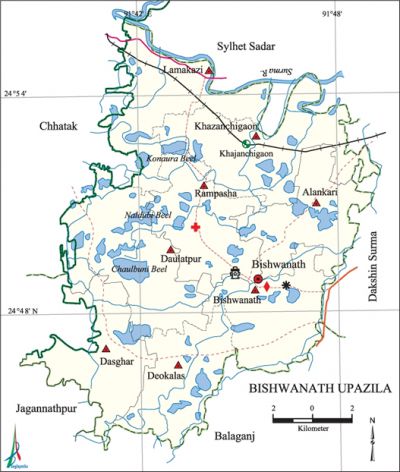Bishwanath Upazila
Bishwanath Upazila (sylhet district) area 214.50 sq km, located in between 24°44' and 24°56' north latitudes and in between 91°39' and 91°50' east longitudes. It is bounded by sylhet sadar and chhatak upazilas on the north, balaganj upazila on the south, dakshin surma upazila on the east, jagannathpur and Chhatak upazilas on the west.
Population Total 189775; male 96741, female 93034; Muslim 180961, Hindu 8731, Buddhist 5, Christian 14 and others 64; 31 indigenous people live in this upazila.
Water bodies Main river: surma; Konaura, Naldubi and Chaulbuni beels are notable.
Administration Bishwanath Thana was formed in 1922 and it was turned into an upazila in 1983.
| Upazila | ||||||||
| Municipality | Union | Mouza | Village | Population | Density (per sq km) | Literacy rate (%) | ||
| Urban | Rural | Urban | Rural | |||||
|
- |
8 |
118 |
448 |
14042 |
175733 |
884 |
45.62 |
39.47 |
| Upazila Town | ||||||||
|
Area |
Mouza |
Population |
Density |
Literacy rate (%) | ||||
|
13.06 |
4 |
14042 |
979 |
45.62 | ||||
| Union | ||||
| Name of union and GO code | Area (acre) | Population | Literacy rate (%) | |
| Male | Female | |||
|
Alankari 10 |
6406 |
12367 |
12547 |
43.72 |
|
Bishwanath 21 |
8231 |
14661 |
13454 |
48.21 |
|
Daulatpur 31 |
8366 |
21741 |
12393 |
38.00 |
|
Deokalas 42 |
5778 |
8350 |
7894 |
40.07 |
|
Dasghar 52 |
5022 |
9055 |
8473 |
38.98 |
|
Khazanchigaon 63 |
6754 |
13413 |
13176 |
40.71 |
|
Lamakazi 73 |
6146 |
11942 |
11497 |
35.81 |
|
Rampasha 84 |
5904 |
14212 |
13600 |
32.75 |
Source Bangladesh Population Census 2001, Bangladesh Bureau of Statistics.

Archaeological heritage and relics Sitla Devi Mandir, Residence of Hasan Raja, Satpari Dighi and ship-shaped house of Gaura Govinda.
History of the War of Liberation During the war of liberation in 1971 the Pak army conducted mass killing and plundering; they also set many houses of the upazila on fire. The Pak army killed many innocent persons including Narayan Sen, Jitendra Das, Bomkesh Chowdhury, Basanta Kumar Das and Dhirendra Kumar Das.
Religious institutions Mosque 346, temple 11, tomb 1.
Literacy rate and educational institutions Average literacy 39.94%; male 43.49%, female 36.31%. Educational institutions: college 3, secondary school 28, primary school 111, kindergarten 23, madrasa 16. Noted educational institutions: Ramsundar High School (1909), Chandvarang High School (1915), Dasghar NU High School (1967), Bishwanath Aalia Madrasa (1960), Sathpur Darul Hadis Aalia Madrasa (1948).
Newspapers and periodicals Weekly: Bishwanath; monthly: Udvash, Bishwanath Digest; quarterly: Pragati.
Cultural organisations Library 1, club 15, playground 5.
Tourist spots Siddha Bakultala of Shree Baishnava Roy at Dasghar, Mazar of Shah Kalu and house of Hasan Raja.
Main sources of income Agriculture 43.85%, non-agricultural labourer 4.28%, industry 0.63%, commerce 13.37%, transport and communication 2.11%, service 4.16%, construction 1.64%, religious service 0.36%, rent and remittance 15.85% and others 13.75%.
Ownership of agricultural land Landowner 44.79%, landless 55.21%; agricultural landowner: urban 44.24% and rural 44.84%.
Main crops Paddy, wheat, potato, sugarcane, chilli, onion, ginger, chick-pea (gram), vegetables.
Extinct or nearly extinct crops Tobacco, jute, black gram.
Main fruits Mango, jackfruit, litchi, black berry, pineapple, betel nut.
Fisheries, dairies and poultries Fishery 30, dairy 22, poultry 38.'
Communication facilities Roads: pucca 21 km, mud road 422 km; railways 45 km; railway stations 2.
Extinct or nearly extinct traditional transport Palanquin, bullock cart, horse carriage.
Cottage industries Goldsmith, blacksmith, potteries, shital pati, weaving, bamboo work, cane work.
Hats, bazars and fairs Hats are bazars are 38, fairs 6, most noted of which are Rampasha Bazar, Bishwanath Bazar and Lamakazi Bazar.
Main exports Paddy, fish, vegetables.
Access to electricity All the unions of the upazila are under rural electrification network. However 35.31% dwellings have access to electricity.
Sources of drinking water Tube-well 65.47%, tap 1.61%, pond 26.92% and others 6%.
Sanitation 28.55% (rural 27.64% and urban 45.57%) of dwelling households of the upazila use sanitary latrines and 62.36% (rural 63.68% and urban 37.67%) of dwelling households use non-sanitary latrines; 9.09% of households do not have latrine facilities.
Health centres Upazila health complex 1, family planning centre 8, satellite clinic 3.
NGO activities asa, brac, bard. '[Jayanta Singh Roy]
References Bangladesh Population Census 2001, Bangladesh Bureau of Statistics; Cultural survey report of Bishwanath Upazila 2007.
